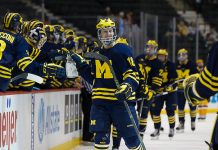First of all, kudos to Wisconsin on a fantastic event Saturday at the Camp Randall Hockey Classic. I watched the game at a Buffalo Wild Wings (so I could watch the Rangers at the same time and have a good seat for UFC 109 as well), and it definitely turned some heads when people saw what was going on.
Sure, there was a little bit of an issue with the ice at one end, but to me, it was more than offset by cool stuff like Scott Gudmanson’s toque, the “IT’S A GREAT DAY FOR HOCKEY” sign on the boards in front of the benches, and of course, Adam Burish helping out on analysis between periods. I spent a fair bit of time talking with Adam during the 2005-06 season hope he heals soon and can continue his career with the Blackhawks, but he’ll be on TV for a long time when he’s done playing.
Anyway, in addition to watching for the event, I also had my eye on Wisconsin’s big stars and Hobey candidates: Brendan Smith, Derek Stepan, Michael Davies and Blake Geoffrion, and for once, I got to see something big from a Hobey contender in a game I was watching, as Smith scored the game-tying and game-winning goals in the third period in a huge comeback for the Badgers (and a heartbreaker for the Wolverines, who really could have used that win for their NCAA tournament chances).
As Smith scored his first goal, I said, “That’s a huge goal for him,” referring to his case as a potential Hobey winner. When he scored his second, I said, “Oh, just give it to him already.” Now, while I may have been a bit premature with that second statement, he’s having a Hobey-caliber season (his 1.27 PPG from the blueline is in the ballpark with Matt Carle’s 1.36 in 2005-06), and scoring two huge goals on a bigtime stage is the kind of performance that definitely gets a player closer to the Hobey.
But it got me thinking about the Hobey race and how best to account for when players put up their points, so I decided to take a closer look.
I’m going to borrow a system from Ken Campbell of the Hockey News, who posts his “Campbellnomics” columns on their website (according to his latest, the system is much kinder than the overall NHL scoring race to former collegians Zach Parise and Mike Cammalleri). Hey, lots of people think a guy named Ken’s system should determine the NCAA tournament teams, right?
The Campbellnomics system awards a point for on six types of goals: the first goal of a game, a goal that ties the game, a goal that produces a lead, the goal that produces the last lead, a goal that leads to a comeback, and an overtime goal. A goal can be counted more than once per category, so, for example, the player who scores the first goal of a shutout win would get three Campbellnomics points: one for the first goal, one for the lead, and one for the last lead. Assists on those goals count as well, but they only count for half a point per category, so the player who assisted on the aforementioned winning goal in a shootout would pick up 1.5 Campbellnomics points.
Now, it’s not an ideal system, from my point of view – I think a goal that stretches a one-goal lead into two or two into three is worthy of consideration – but it’s a pretty good way to go inside the numbers.
So, I’m going to take the Campbellnomics system and apply it to 30 skaters, five forwards from each of the “Big Four” conferences, five forwards from Atlantic Hockey and the CHA, and five defensemen. I’m not saying this is the be-all and end-all of who should be in the Hobey picture, but it’s something else to think about.
So, let’s get started with the Atlantic Hockey and CHA guys. There seems to be one spot a year reserved for a player from one of those conferences, and there are a number of worthy candidates for that spot this year, so it seemed like a natural to compare these guys first.
Canisius forward Cory Conacher has surged to the top of the national scoring chart this year, currently averaging 1.62 points per game on 18 goals and 24 assists in 26 games. Based on when those points were registered, though, his 42 points translate to 18.5 Campbellnomics points, or .71 CPPG (Campbellnomics Points Per Game).
Air Force forward Jacques Lamoureux has fallen off a bit from his scoring pace of a season ago, when he was No. 2 in the nation in points per game with 1.29 PPG, and tops in goals with 33. On the overall scoring chart, Lamoureux’s 1.17 PPG is almost half a point per game behind Conacher’s pace. However, Campbellnomics gives him 24 points in 30 games this season, placing him ahead of Conacher with .80 CPPG.
Sacred Heart had a 12-game unbeaten streak snapped by RIT on Friday night, but the Pioneers won Saturday to give them an 11-1-2 record in their last 14 games, making them one of the hottest teams in college hockey. The driving forces behind Sacred Heart’s success have been senior forwards Nick Johnson and Dave Jarman, who are currently tied for fourth in the national scoring race, averaging 1.39 points on 39 points in 22 games. The Campbellnomics system, however, awards Johnson 20.5 points, while helper-happy Jarman comes up shorter with 16 points, giving Johnson and Jarman averages of .73 CPPG and .57 CPPG, respectively.
Finally, we’ll jump over to the CHA and take a look at Bemidji State forward Matt Read, who’s been the conference’s top player from the drop of the first puck this season. Now, Read’s Hobey Buzz has fallen off since the early going, but he’s still one of the nation’s top 20 scorers – 19th, to be exact – with 14 goals and 18 assists in 26 games, an average of 1.23 points per game. Meanwhile, Campbellnomics awards him 19 points, an average of .73 CPPG.
So, just to recap:
Jacques Lamoureux, Air Force: .80 CPPG
Matt Read, Bemidji State: .73 CPPG
Nick Johnson, Sacred Heart, .73 CPPG
Cory Conacher, Canisius, .71 CPPG
Dave Jarman, Sacred Heart, .57 CPPG
So, does that mean to pencil in Lamoureux for a Hobey finalist spot? Not necessarily. What we need to remember here is that Read leads a team that is ranked No. 7 in the country, and is in contention for a top-four seed in the NCAA tournament. The same can not be said for Air Force, which needs to win Atlantic Hockey to make the NCAA tournament. That’s a big difference maker.
Of course, Lamoureux also has the benefit of playing for a service academy, which ties in with the history of Hobey Baker, and a personal story and record of community work that bolster his case.
Could there be room for both? Possibly. But if there’s only one, my guess is that Read has the edge.
In any event, I think that Conacher is a candidate to go the way of Brian Leitch, Dave Borelli, and others who have posted big numbers but failed to receive Hobey recognition. But then again, he’s just a junior, so there’s always next year.
But that’s just me. What do you think? You think Ken Campbell’s onto something?


